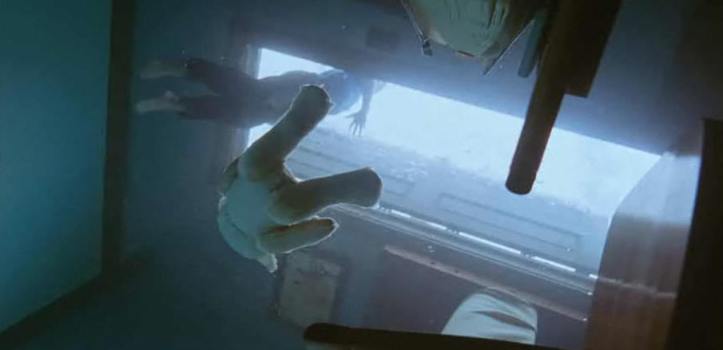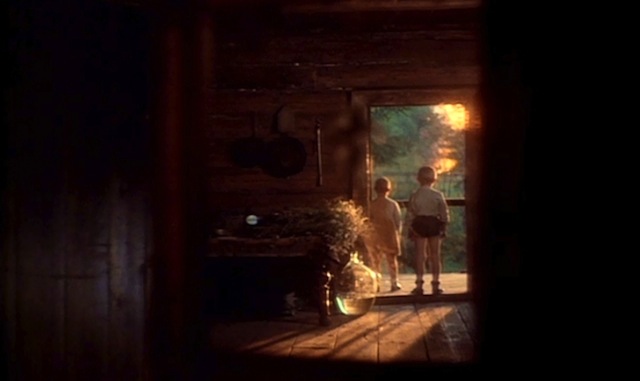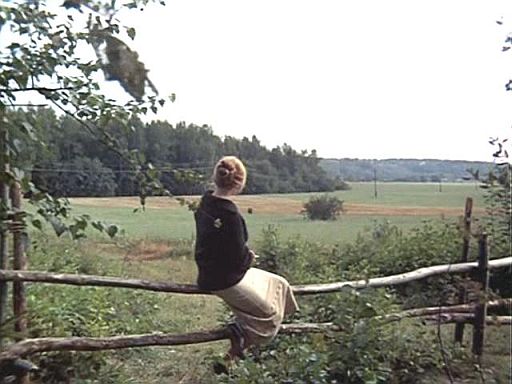
Still awash in fresh memories of Terrence Malick’s The Tree of Life, I watched for the first time Andrei Tarkovsky’s 1975 film The Mirror. The problem I’ve had with Tarkovsky films in the past (especially Stalker, which I found tedious and nearly impenetrable though certain moments and images have stubbornly stuck with me) is that I feel like you need an advanced degree in Russian history to understand the context and symbolism. With Malick’s film, however, illuminating the way, I found Tarkovsky’s The Mirror to be deeply rewarding on multiple levels, and it emerged as an unforgettable cinematic experience deserving of repeated views.
The two films are strikingly similar: deeply personal, semi-autobiographical, supplemented by other art forms (classical music is used exquisitely in both, while The Mirror also drew upon original poetry) and constructed in a stream-of-consciousness style made to evoke dreams and memories. Both films are deeply rooted in the childhoods of their makers.

In Tarkvosky’s vision, tragedy befalls the family in the form of the father abandoning his children while in Malick’s world the death of a middle son/brother reigns paramount. While Tarkovsky intercuts images from Russian/world history running parallel to his childhood, Malick bookends his story of growing-up and innocence lost with the creation of the universe and the end of time. Both men wrestle with idyllic visions of nature and the safety of childhood homes while populating their fiction with archetypal mother issues – both gift to their loving mothers the ability to float and the ability to engender resentment and guilt.


The Mirror and The Tree of Life, however, exist not in a vacuum where one inspired the other. They belong to the grand tradition of auteurs recasting their childhoods and dysfunctions in the shape of cinema where film acts a recorder of memory and a mirror to our souls. Similarly, at the end of his career, Ingmar Bergman gave birth to his epic ode to childhood, Fanny and Alexander, while in more accessible and populist fashion John Boorman painted blitzkrieg-riddled Great Britain during WWII through the nostalgia-tinted frames of children at play in Hope and Glory.
Musing on this notion and grand cinematic tradition, I decided to imagine what it would be like if other contemporary auteurs decided to follow suit. In a fit of madness, with a bit of fun and hypothetically speaking…
The Schleicher Spin Presents…
David Lynch’s Himalayan Highway
Premise: Lynch’s film opens with a shot of a young girl dressed in a poodle-skirt and bobby-sox dancing in front of a mirror in a dingy, red-velvet draped Euro-trash hotel room. In the mirror, we suddenly see flashes of light. The camera zooms in on the bureau in front of the mirror and there we see an iPad. The girl holds it up to the mirror, and on the screen there’s a grainy video image playing on YouTube of an old man (Kyle MacLachlan in heavy make-up) lying on his deathbed in the Himalaya mountains surrounded by sherpas. We are transported there, and the old man begins to drift back in time to his childhood.
A young boy and Eagle-scout in an undisclosed Norman Rockwell-esque Midwestern city has trouble wrestling fact from fiction. His imagines his mother (played by Marion Cotillard) as Marilyn Monroe (played by Scarlett Johansson). When the real Marilyn Monroe overdoses on drugs and dies, the grief-stricken young boy runs off to join a circus and years later lands himself in a hellish phantasmagoria-version of early 1970’s Philadelphia married to a midget woman and attending art school to become a painter.
Eventually the painter finds his way to Los Angeles where he begins to study transcendental meditation and at the age of 65 finally achieves full levitation only to be diagnosed with fatal lung cancer. He decides to make a pilgrimage to the Himalaya mountains, where he finds a French prostitute in search of herself (Marion Cotillard – again) who becomes his last great love. The film closes with a silent shot of hundreds of yogis seated in lotus positions taking flight out of the mountains while a young American boy films it all on his smart phone to post on YouTube.
Reaction: Critics will be as baffled by a graphic sex-scene involving an amputee and a midget as they will be by a ten minute sequence of Kyle MacLachlan cooking quinoa. Scarlett Johansson will receive her first Best-Supporting Actress Oscar nomination but lose to Natalie Portman playing a Holocaust survivor. Angelo Badalamenti will finally get an Oscar for Best Score. The film will gross twice as much in France as it does in the United States. Lynch will never make another film.
Lars Von Trier’s Enfant Terrible
Premise: It will finally be revealed that the top-secret 30-year long film project Von Trier has been working on is his own distorted autobiography. Von Trier tells the story of his childhood through actual home movies shot throughout Scandinavia and northern Europe over the last 30 years of real families living amongst communes, Gypsy carnivals, religious cults and nudist camps. Spliced with the homes movies are stick-figure re-enactments of famous scenes from Greek tragedies and explicit sexual debauchery featuring nuns filmed in washed-out sepia tones turned upside down. The film ends with a close-up of Von Trier poking out his own eyes.
Reaction: Critics will hail the film as the greatest piece of “torture-porn” ever crafted. No one will distribute the film theatrically in the US, but it becomes a cult hit when it’s picked up eventually on Netflix. Now blind, Von Trier will go on to make three more films before he dies of mercury poisoning at the age of 67.
Werner Herzog’s Flight of the Dolphins
Premise: The film opens with an old man and a grizzly bear under hypnosis being admitted to a mental institution by an angry old woman cursing in an unidentifiable language. In the common room, the old-man and the bear calmly watch on television a movie about a family that flees WWII-riddled Munich for a remote village in the Bavarian Alps after their neighbor’s house is bombed. The infant son grows into a boy who defiantly becomes mute after being forced to sing in school. He remains mute until he finds a 35mm camera and begins to make films.
As he grows older, the filmmaker travels the world, marries a zoologist whose life’s work is studying the social hierarchies of Capuchin monkeys, meets a real-life vampire, and becomes an explorer who goes deep cave spelunking in Central and South America. All the while he is constantly haunted by memories of his childhood and his days as a mute roaming about the quaint Bavarian village in the mountains. The film ends with a scene of snow falling on the Amazon while the same old man from the opening of the film swims with the famous pink dolphins that inhabit the river.
Reaction: The scenes of his childhood in Bavaria are praised for their realism and natural beauty while his use of CGI snow in the closing Amazon scene is decried as a self-indulgent betrayal of his own cinematic ideals. Herzog promptly tells the world to “go to hell” and proceeds to make, out of a spite, a series of low-budget action films in Brazil before retiring to Bavaria.
And now last…and certainly least…
Michael Bay’s Freedom Fighter
Premise: In Southern California, in the summer of 1976, a blonde-haired, blue-eyed teenage surfer boy gets involved in an underground drag-racing ring despite the pleas of his hysterical and recovering drug-addict mother (played by Vera Farmiga) to get on the straight and narrow. Amidst the fireworks on July 4th, a race of malevolent aliens invade California and wreak 200 million dollars worth of CGI havoc. Just before being abducted by the aliens, the boy learns from his mother (moments before she is killed in a massive explosion) that the man she always told him was his father isn’t really his father, and that he instead is the son of a deceased African-American boxer.
While trapped on the mother-ship and forced into an inter-galactic, fight-to-the-death, Mixed Martial Arts tournament, the boy starts wearing black-face and falls in love with a 3D four-breasted alien (played Avatar-style by Bay’s current Playboy bunny girlfriend). The boy kicks multiple alien ass, has cosmic sex with his 3D four-breasted girlfriend, and then commandeers the mother-ship and drag-races it across California.
Reaction: The film will go down in history as the first to be shot entirely in slow-mo — because, as Bay explains, it speaks both to the heightened drama and the slower paced time-period of the 1970’s. Even in slow-mo, there’s not a single static shot. The film will gross 1 billion dollars world-wide and win Oscars for Best Visual Effects and Best Make-up. Michael Bay will then enter what future film historians will look back on as his Renaissance Period.

I watched Mirror for the first time soon after seeing The Tree of Life as well. They do have remarkable similarities, but just as many differences. Mirror, for instance, is more radically non-narrative, and seems to move from scene to scene and theme to theme with no perceivable logic, though one feels the governing hand of an artist behind it, even if we have no idea how/what he’s doing. While I think TOL is one of the greatest films I’ve ever seen, and it affects me emotionally/spiritually like few other films, I also felt while watching Mirror that in some ways it was “better.” That is, I felt Tarkovsky gave his images a kind of primeval weirdness and thematic weight that Malick doesn’t, and while I didn’t “get” or “feel” Mirror in the same way I do TOL, it seemed a more eternal, monumental, timeless work of art. But then, I’m not sure that’s really the right way to look at it. Malick and Tarkovsky are going for different things (and this goes for all their movies). Malick is going for a more stream-of-consciousness poetry, an approach that attempts to find beauty everywhere, in all creation, which leads to a constant moving of the eyes, seeing wonder everywhere. Tarkovsky wants to find beauty, but he is also more concerned with violence, death, destruction, and ugliness than Malick, and for him it is always a struggle to find the beauty in the midst of the madness. He is a poet as well, but it is a poetry of stark, staring images from which one can’t look away, and he leaves them onscreen seemingly forever. This grants his films a feeling of greater weight than the constant cutting of Malick, but that doesn’t necessarily mean a greater level of artistry, or a disproving of TOL, a cutting it down to size as an unmemorable, un-profound bunch of pretty images. It’s just different, looking at things in a different way.
Anyway, that’s my random thoughts on the two movies as of this moment. Sorry for the length.
Oh, and I LOLed at this: “the man she always told him was his father isn’t really his father, and that he instead is the son of a deceased African-American boxer.”
StephenM – thanks for the thoughtful response! I like how you described The Mirror as “primeval” – and in many ways I feel similarly about the two films (TOL being more emotionally effecting, but The Mirror seeming more monumental). I agree Tarkovsky is the “darker” artist while Malick finds beauty in everything (even in crying and tragedy). Glad I got a laugh out of you with my movie ideas! –DHS
The poetry in Mirror is not by Andrei Tarkovsky, but by his father, Arseniy Tarkovsky